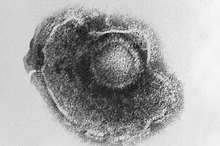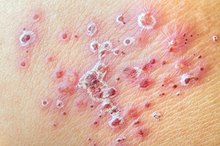A Rash After the Shingles Vaccine
In May 2006, the Food and Drug Administration approved a vaccine, known as Zostavax, to prevent shingles in adults over 60 2. According to the National Institute of Neurological Disorders and Stroke, the shingles vaccine reduces the risk of developing shingles by half and reduces the risk of the most common complication of shingles, a chronic pain syndrome known as post-herpetic neuralgia, by more than two-thirds 1. In the May 4, 2010 edition of “Annals of Internal Medicine,” New York University infectious disease specialist Michael S. Simberkoff, M.D., and other members of the Shingles Prevention Study Group report that rash is the most common side effect of the shingles vaccine 3.
If you are experiencing serious medical symptoms, seek emergency treatment immediately.
Characteristics
Patients who participated in the study developed two types of rashes, according to Simberkoff. The first type of rash consisted of a small number of blisters similar to shingles that developed at the injection site and did not spread. The second type of rash consisted of blisters similar to shingles that developed on a part of the body other than the injection site. These blisters, say Simberkoff and colleagues, tended to be more numerous and affected a larger area of skin, similar to naturally occuring shingles.
- Patients who participated in the study developed two types of rashes, according to Simberkoff.
- The second type of rash consisted of blisters similar to shingles that developed on a part of the body other than the injection site.
Onset
The Stages of Shingles Rash
Learn More
Patients were asked to report all rashes that developed within 42 days of receiving the shingles vaccine. Patients who experienced injection site rashes developed them sooner—two to three days after receiving the vaccine, on average-- than patients who experienced rashes elsewhere on the body, which typically appeared more than two weeks after vaccine administration.
Duration
Rashes that occurred at the injection site resolved, on average, within 5 days compared to 18 days for rashes that occurred elsewhere on the body, according to the Shingles Prevention Study Group. Rashes that occurred elsewhere likely reflected vaccine failure, rather than a side effect of vaccination. In all but a few patients, laboratory tests confirmed that the cause of the rashes was, in fact, shingles, but not the strain of the virus that was used in the vaccine.
Prevalence
A Mild Case of Shingles
Learn More
According to the FDA, less than 1 percent of patients who received the vaccine developed a rash. Rashes occurred slightly more often—0.7 percent versus 0.1 percent—in people who received the vaccine, compared to people who received a placebo, suggesting that rash is, in fact, a side effect of the vaccine. Rashes were also more common in younger—60- to 69-year-old—patients compared to patients over 70.
Complications
In rare cases, a rash after the shingles vaccine may signal a complication, such as an allergic reaction or an infection. Symptoms of an allergic reaction, according to MedlinePlus, include chest pain or tightness, nausea, vomiting, diarrhea, breathing or swallowing problems, facial flushing or swelling, dizziness, anxiety, fear or apprehension 4. Symptoms of infection include injection site discharge or fever. Patients who experience these symptoms should contact their doctors for instructions or go to the emergency room.
- In rare cases, a rash after the shingles vaccine may signal a complication, such as an allergic reaction or an infection.
Related Articles
References
- National Institute of Neurological Disorders and Stroke: Shingles: Hope Through Research
- Food and Drug Administration: Zostavax: Zoster Vaccine Live
- "Annals of Internal Medicine: Safety of Herpes Zoster Vaccine"; Shingles Prevention Study Group; May 4, 2010
- MedlinePlus: Allergic Reactions
- InformedHealth.org [Internet]. Cologne, Germany: Institute for Quality and Efficiency in Health Care (IQWiG); 2006-. Shingles: Overview. 2014 Nov 19 [Updated 2019 Nov 21].Available from: https://www.ncbi.nlm.nih.gov/books/NBK279624/
- Albrecht, M. Shingles (Beyond the Basics). UpToDate. Updated June 12, 2019.
- National Center for Immunization and Respiratory Diseases, Division of Viral Diseases. Shingles (Herpes Zoster): Clinical Overview. Centers for Disease Control and Prevention. Updated August 14, 2019. cdc.gov
- National Center for Immunization and Respiratory Diseases. Shingles Vaccination. Centers for Disease Control and Prevention. Updated January 25, 2018. cdc.gov
- John AR, Canaday DH. Herpes Zoster in the Older Adult. Infect Dis Clin North Am. 2017;31(4):811-826. doi:10.1016/j.idc.2017.07.016
- Cohen KR, Salbu RL, Frank J, Israel I. Presentation and management of herpes zoster (shingles) in the geriatric population. P T. 2013;38(4):217–227.
- National Institute of Neurological Disorders and Stroke. Shingles: Hope Through Research. Updated August 13, 2019. ninds.nih.gov
- White PF, Elvir lazo OL, Galeas L, Cao X. Use of electroanalgesia and laser therapies as alternatives to opioids for acute and chronic pain management. F1000Res. 2017;6:2161. doi:10.12688/f1000research.12324.1
- Centers for Disease Control and Prevention. Chickenpox Vaccination: What Everyone Should Know. Updated August 7, 2019. cdc.gov
- InformedHealth.org [Internet]. Cologne, Germany: Institute for Quality and Efficiency in Health Care (IQWiG); 2006-. Shingles: Overview. 2014 Nov 19 [Updated 2019 Nov 21].
- Albrecht, M. Shingles (Beyond the Basics). Updated June 12, 2019.
- Centers for Disease Control and Prevention. What Everyone Should Know About Zostavax. Updated January 25, 2018.
Writer Bio
Heather Gloria began writing professionally in 1990. Her work has appeared in several professional and peer-reviewed publications including "Nutrition in Clinical Practice." Gloria earned both a Bachelor of Science in food science and human nutrition from the University of Illinois. She also maintains the "registered dietitian" credential and her professional interests include therapeutic nutrition, preventive medicine and women's health.






